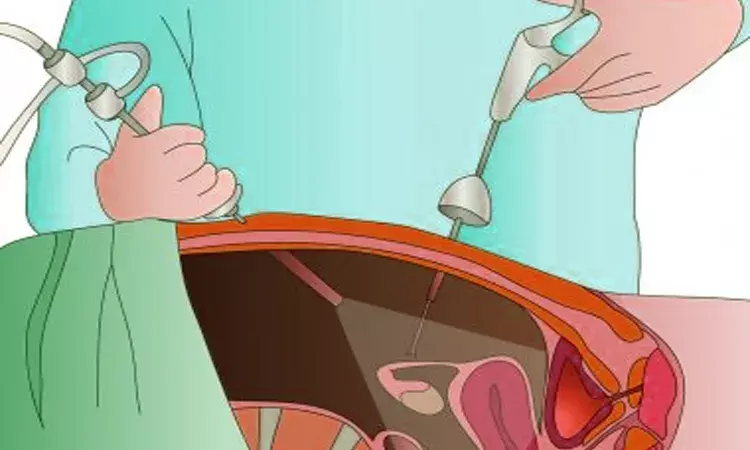- Home
- Medical news & Guidelines
- Anesthesiology
- Cardiology and CTVS
- Critical Care
- Dentistry
- Dermatology
- Diabetes and Endocrinology
- ENT
- Gastroenterology
- Medicine
- Nephrology
- Neurology
- Obstretics-Gynaecology
- Oncology
- Ophthalmology
- Orthopaedics
- Pediatrics-Neonatology
- Psychiatry
- Pulmonology
- Radiology
- Surgery
- Urology
- Laboratory Medicine
- Diet
- Nursing
- Paramedical
- Physiotherapy
- Health news
- Fact Check
- Bone Health Fact Check
- Brain Health Fact Check
- Cancer Related Fact Check
- Child Care Fact Check
- Dental and oral health fact check
- Diabetes and metabolic health fact check
- Diet and Nutrition Fact Check
- Eye and ENT Care Fact Check
- Fitness fact check
- Gut health fact check
- Heart health fact check
- Kidney health fact check
- Medical education fact check
- Men's health fact check
- Respiratory fact check
- Skin and hair care fact check
- Vaccine and Immunization fact check
- Women's health fact check
- AYUSH
- State News
- Andaman and Nicobar Islands
- Andhra Pradesh
- Arunachal Pradesh
- Assam
- Bihar
- Chandigarh
- Chattisgarh
- Dadra and Nagar Haveli
- Daman and Diu
- Delhi
- Goa
- Gujarat
- Haryana
- Himachal Pradesh
- Jammu & Kashmir
- Jharkhand
- Karnataka
- Kerala
- Ladakh
- Lakshadweep
- Madhya Pradesh
- Maharashtra
- Manipur
- Meghalaya
- Mizoram
- Nagaland
- Odisha
- Puducherry
- Punjab
- Rajasthan
- Sikkim
- Tamil Nadu
- Telangana
- Tripura
- Uttar Pradesh
- Uttrakhand
- West Bengal
- Medical Education
- Industry
Laparoscopic Supracervical Hysterectomy safer than total Laparoscopic Hysterectomy among patients with uterine fibroids: Study

Researchers have found in a new research that Laparoscopic supracervical hysterectomy (LSH) has a lower risk of short-term postoperative complications compared to total laparoscopic hysterectomy (TLH) in patients with uterine fibroids. Therefore these findings support informed, shared decision-making when considering minimally invasive hysterectomy for uterine fibroids. Hysterectomy is the standard surgical treatment for uterine fibroids in the United States, but there has been limited information on how the two most common minimally invasive surgical methods impact patient outcomes. The study was conducted by Raanan M. and published in the American Journal of Obstetrics and Gynecology.
This cohort study used data from the American College of Surgeons National Surgical Quality Improvement Program database of cases from 2012 to 2020. The analysis involved 50,796 women who had total laparoscopic hysterectomy (44,413 patients) or laparoscopic supracervical hysterectomy (6383 patients) performed for the purpose of uterine fibroids. Researchers compared 30-day postoperative complications, classified based on the Clavien-Dindo classification. Variables like age, body mass index, race, comorbidities, American Society of Anesthesiologists classification, uterine weight, and other surgical procedures were compared using multivariate regression to identify their role in postoperative results.
Key Findings
Operative Time:
• Mean operative time was considerably less for total laparoscopic hysterectomy (143.0 minutes) than for laparoscopic supracervical hysterectomy (150.6 minutes, p<.001).
• Uterine Weight
• The rate of patients with uterine weights over 250 g was lower in the total laparoscopic hysterectomy group (39.4%) than in the laparoscopic supracervical hysterectomy group (45.1%, p<0.001).
Overall Complication Rates:
• Any complications after the operation were more in the group that underwent total laparoscopic hysterectomy (6.6%) than in the group that underwent laparoscopic supracervical hysterectomy (5.3%, p<0.001).
Major Complications:
• Major complications were also more with total laparoscopic hysterectomy (2.7%) than with laparoscopic supracervical hysterectomy (1.6%, p<0.001).
Minor Complications:
• Rates of minor complications did not significantly differ between both groups (total laparoscopic hysterectomy: 4.4%, laparoscopic supracervical hysterectomy: 4.1%, p=0.309).
Adjusted Odds Ratios:
• Laparoscopic supracervical hysterectomy was independently linked with lower risk of any postoperative complication (adjusted OR: 0.79; 95% CI: 0.70–0.88).
• It also carried a much lower risk of major complications (adjusted OR: 0.55; 95% CI: 0.44–0.69).
This research concludes that laparoscopic supracervical hysterectomy has a reduced risk of short-term postoperative complications when compared to total laparoscopic hysterectomy in uterine fibroid patients. These findings reinforce the importance of personalized surgical planning and can aid patients and surgeons to select the ideal minimally invasive hysterectomy method.
Reference:
Meyer R, Hamilton KM, Schneyer RJ, Levin G, Truong MD, Wright KN, Siedhoff MT. Short-term outcomes of minimally invasive total vs supracervical hysterectomy for uterine fibroids: a National Surgical Quality Improvement Program study. Am J Obstet Gynecol. 2025 Apr;232(4):377.e1-377.e10. doi: 10.1016/j.ajog.2024.10.006. Epub 2024 Oct 14. PMID: 39413898.
Dr Riya Dave has completed dentistry from Gujarat University in 2022. She is a dentist and accomplished medical and scientific writer known for her commitment to bridging the gap between clinical expertise and accessible healthcare information. She has been actively involved in writing blogs related to health and wellness.
Dr Kamal Kant Kohli-MBBS, DTCD- a chest specialist with more than 30 years of practice and a flair for writing clinical articles, Dr Kamal Kant Kohli joined Medical Dialogues as a Chief Editor of Medical News. Besides writing articles, as an editor, he proofreads and verifies all the medical content published on Medical Dialogues including those coming from journals, studies,medical conferences,guidelines etc. Email: drkohli@medicaldialogues.in. Contact no. 011-43720751


